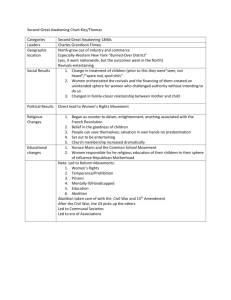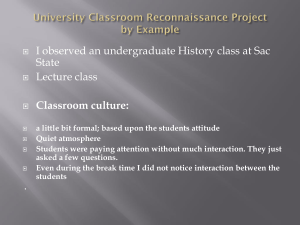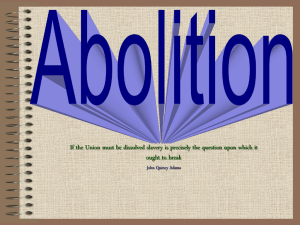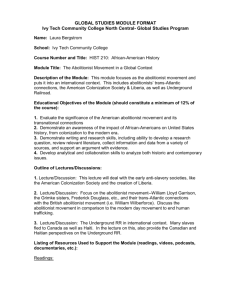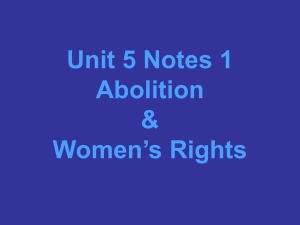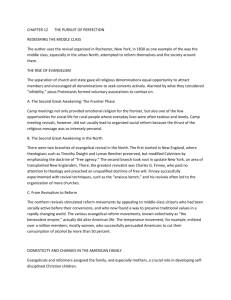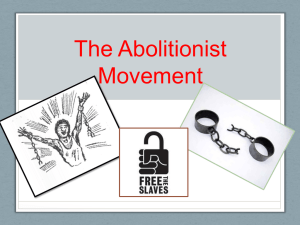Rise of Popular Religion - Rabun Gap
advertisement
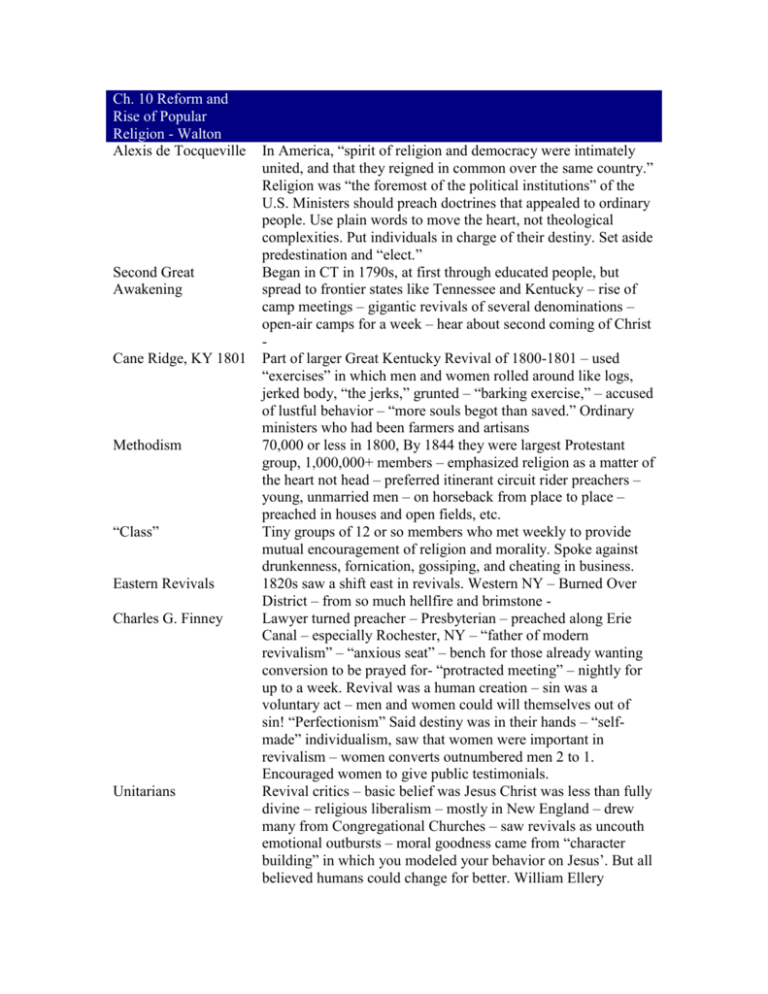
Ch. 10 Reform and Rise of Popular Religion - Walton Alexis de Tocqueville Second Great Awakening Cane Ridge, KY 1801 Methodism “Class” Eastern Revivals Charles G. Finney Unitarians In America, “spirit of religion and democracy were intimately united, and that they reigned in common over the same country.” Religion was “the foremost of the political institutions” of the U.S. Ministers should preach doctrines that appealed to ordinary people. Use plain words to move the heart, not theological complexities. Put individuals in charge of their destiny. Set aside predestination and “elect.” Began in CT in 1790s, at first through educated people, but spread to frontier states like Tennessee and Kentucky – rise of camp meetings – gigantic revivals of several denominations – open-air camps for a week – hear about second coming of Christ Part of larger Great Kentucky Revival of 1800-1801 – used “exercises” in which men and women rolled around like logs, jerked body, “the jerks,” grunted – “barking exercise,” – accused of lustful behavior – “more souls begot than saved.” Ordinary ministers who had been farmers and artisans 70,000 or less in 1800, By 1844 they were largest Protestant group, 1,000,000+ members – emphasized religion as a matter of the heart not head – preferred itinerant circuit rider preachers – young, unmarried men – on horseback from place to place – preached in houses and open fields, etc. Tiny groups of 12 or so members who met weekly to provide mutual encouragement of religion and morality. Spoke against drunkenness, fornication, gossiping, and cheating in business. 1820s saw a shift east in revivals. Western NY – Burned Over District – from so much hellfire and brimstone Lawyer turned preacher – Presbyterian – preached along Erie Canal – especially Rochester, NY – “father of modern revivalism” – “anxious seat” – bench for those already wanting conversion to be prayed for- “protracted meeting” – nightly for up to a week. Revival was a human creation – sin was a voluntary act – men and women could will themselves out of sin! “Perfectionism” Said destiny was in their hands – “selfmade” individualism, saw that women were important in revivalism – women converts outnumbered men 2 to 1. Encouraged women to give public testimonials. Revival critics – basic belief was Jesus Christ was less than fully divine – religious liberalism – mostly in New England – drew many from Congregational Churches – saw revivals as uncouth emotional outbursts – moral goodness came from “character building” in which you modeled your behavior on Jesus’. But all believed humans could change for better. William Ellery Mormons Joseph Smith Nauvoo, Illinois Polygamy 1843 Mormon growth Brigham Young Shakers Reform Age Temperance Channing – Unitarian leader 1820s/30s – Church of Jesus Christ of Latterday Saints Founder of Mormonism – from Palmyra, NY – lived in burned over district – lots of religious fervor – claimed an angel led him to a buried book of revelation and to special stones used for translating it. He came up with Book of Mormon – 1827 – story of ancient Hebrew prophet, Lehi – descendants came to America – Jesus had appeared in North American to them – performed miracles – God cursed some who were quarrelsome with dark skin = American Indians. Its appeal was America was at center of Christian history and a new revelation had come. Mormons moved here to build model city and temple – wanted to be closer to Indians to convert them and escape persecution. Smith claimed a new revelation sanctioning multiple wives – Saw himself as a prophet of the kingdom of God – called a Second Mohammed – 1844 announced his candidacy for presidency of US – charged with treason – jailed in Carthage, ILL. – murdered there along with his brother by a mob in June 1844. Went from 6,000 in 1840 to 200,000 by 1870. Many in English factory cities. New leader, led them to Great Salt Lake Valley of Utah – then under the control of Mexico. Established an independent republic – Deseret – they prospered. Industrious, deeply committed to welfare of other Mormons, public projects like irrigation to benefit all, appealed to downtrodden and insecure. Convulsive dance part of their ceremony – Mother Ann Lee – illiterate daughter of English blacksmith – New Lebanon, NY – able artisans – famous for beauty and craftsmanship of their furniture – abstained from sexual intercourse – believed end of world was imminent, trances, heavenly visions, etc. In Second Coming, Jesus would take the form of a woman, herself. Shaker missionaries made converts – 6,000 spread over 8 states. Lived apart from society. Large numbers of men and women became active in improvement organizations. Sometimes allied with political party of Whigs. Loyalty to causes mostly, not parties. Used name of God. Intense moralism. Many religious liberals who were hostile or indifferent to revivals. Borrowed evangelical language and psychology in calling for moral change. Had a “dark” side – used coercion – regional – much from New England – much less so in South. War on liquor – annual per capita consumption of rum, whiskey, gin, and brandy exceeded 7 gallons by 1830, nearly 3X today’s rate. By late 1820s, average adult male drank ½ pint of liquor a day. Seen as male indulgence that hurt women and children – Washington Temperance Societies School Reform Horace Mann 1852 – MA – 1st compulsory school law Abolition David Walker 1829 women were very involved in temperance – Lyman Beecher (Harriet’s father) – 6 lectures criticizing alcohol – By 1834, 5,000 state and local temperance societies were loosely affiliated with American Temperance Society. Demanded total abstinence. Grog on the job came under attack from manufacturers. Baltimore 1840 – more likely to be mechanics (workingmen) and laborers. Many were reformed drunks. Had some connection to revivals – viewed drinking as sinful – had “experience meetings” in which they sought “salvation” from liquor and “regeneration” through abstinence “teetotalism.” Wives joined “Martha Washington” societies – pledged to smell their husbands breath each night. Shifted tactics to cities and towns and states banning alcohol – 1838 Mass – prohibited sale of distilled spirits in amounts less than 15 gallons – 1851 Maine banned manufacture and sale of all intoxicating beverages – per capita consumption when down in 1830s. In 1840s, it was less than half that in the 1820s. One-room log cabin – pupils from 3 to 20 in number, harsh discipline, primitive conditions. But need to equip children for emerging competitive and industrial economy. Massachusetts 1837 – 1st sec. of MA’s newly created board of education. Financial support from parents to state, classify students by age and attainment, school term from 2/3 months to 10 months, standardized textbooks, compelling attendance. Spread uniform cultural values. Learn punctuality. Stimulate competitiveness, common values – McGuffey Readers – sold 50 million copies between 1836 and 1870 – created a common curriculum – preached industry, honesty, sobriety, and patriotism. Few gains in South, most gains in North. Urban Catholics protested textbooks with anti-Catholic and antiIrish barbs. Laboring poor worried about loss of children working and income. Urban workingmen’s parties of 1820s supported it, manufacturers wanted a disciplined work force. Women supported it through teachings. By 1900, 70% of nation’s teachers were women. Used to forge a common American culture in face of massive immigration. Left out black children, however. 1800 – 1830 – American Colonization Society – founded 1817 – called for gradual emancipation, compensation of slaveowner – shipment of freed blacks to Africa. Not enough funds to buy freedom of more than a fraction of slaves. Between 1820 and 1830, only 1,400 blacks migrated to Liberia and most were already free. American slave population (natural increase) rose from 1,191,000 in 1810 to 2,000,000+ in 1830. Most blacks did not want to go to Africa. America was home. Appeal – Boston free black – called for black rebellion to crush Benjamin Lundy 1821 William Lloyd Garrison 1831 Frederick Douglass Elijah Lovejoy Lane Theological Seminary American AntiSlavery Society 1833 Liberty Party 1840 Abolition Divisiveness Angelina and Sarah Grimke slavery Quaker – “Genius of Universal Emancipation” – put forth proposals that no new slave states be admitted, internal slave trade should be outlawed, 3/5 clause of Constitution should be repealed, Congress should abolish slavery wherever it had the authority to do so. New Englander – The Liberator newspaper – most famous and controversial white abolitionist. “I will be Heard.” – immediate abolition – blacks should have civil (legal) equality with whites. Many black abolitionists supported him. He soon called for a rejection of ALL laws and governments, as well as political parties, as part of his doctrine of nonresistance.” 1838 – New England Nonresistance Society – slavery depended on force; all governments ultimately rested on force; even laws passed by elected legislatures needed police enforcement. Force was the opposite of Christian love; Christians should refuse to vote, hold office, or have anything to do with government. Garrison also supported women’s rights and urged that women be given positions equal to men in the American Anti-Slavery Society. Early issues of “The Liberator” had a picture of a kneeling slave woman imploring, “Am I Not a Woman and a Sister?” Said the South was a vast brothel and described slave women as treated badly. Douglass – escaped slave – “I appear before the immense assembly this evening as a thief and a robber.” “I stole this head, these limbs, this body from my master, and ran off with them.” White abolitionist murdered by a mob in Alton, Illinois, 1837 1834 – more antislavery than most religious institutions – many preachers were weak on abolition – Led by Theodore Dwight Weld “Lane rebels” left to go to the antislavery Oberlin College in Ohio Battles between Garrison and prominent NY and Midwestern abolitionists such as the brothers Lewis and Arthur Tappan, Theodore Dwight Weld, and James G. Birney. Should the abolitionists enter politics as a separate party? Birney ran for president on the ticket of the newly formed Liberty Party. A. Politics/parties or not? This issue divided abolitionists – see above “nonresistance” by Garrison B. Role of women? Garrison supported it, but many abolitionists opposed it including Theodore Dwight Weld Daughters of South Carolina slaveholder – against slavery – they drew mixed audiences of men and women. Sarah – “Letters on the Condition of Women and the Equality of the Sexes” Angelina – “Letters to Catharine E. Beecher” – daughter of Abby Kelley 1840 Abolition growth 1836 Gag Rule Women’s Rights Lucy Stone 1840s 1848 Lucretia Mott and Elizabeth Cady Stanton Seneca Falls 1848 Prisons and Asylums Lyman Beecher and militant opponent to female equality (married to Theodore Dwight Weld). Elected to previously all-male committee – split the American Anti-Slavery Society in two. A substantial minority of profeminist delegates left – some to join the Liberty Party – others to follow Lewis Tappan into the new American and Foreign Anti-Slavery Society. By 1840 – more than 1,500 abolitionist societies mostly in MA, NY, and Ohio. Flooded Congress with petitions calling for an end to slavery in the District of Columbia. Automatically tabled abolitionist petitions and prevented discussion of them in Congress. Result of so many abolitionist petitions. It was repealed in 1845. Issue became constitutional rights of free expression and petitioning Congress. The South was on the defensive, and this led them to error with the gag rule. 1830s – women could not vote. If married, had no right to own property (even inherited property), could not retain their own earnings. Separate sphere argument hurt women. Justified reform activities on behalf of the family, but undercut women’s demands for legal equality. Leave politics and finance to men. Women worked more for abolition, then moved into women’s rights. First abolitionist to lecture solely on women’s rights. Lucretia Mott had been made to sit in a screened-off area at the World’s Anti-Slavery Convention in London in 1840. Stanton had accompanied her abolitionist husband to the meeting as a honeymoon trip. Women’s rights convention in Seneca Falls, NY – Declaration of Sentiments – patterned after American Declaration of Independence – “all men and women are created equal.” 12 resolutions – all but the one on women voting passed unanimously; but it did pass. It took until 1920 for women to get the right to vote in national elections. Slow to get rights because abolition was linked to it and abolition was unpopular – also, domesticity provided opportunities for women WITHOUT the need to vote. Colonial era – poverty as neither the fault of its victims nor a sign of defective social order – seen as permanent condition of society, ordained by God to test Christians’ humility and charity. Crime was seen as enduring part of society. Early 1800s – a. poverty and crime were rising b. in cities, crime and poverty were more visible c. deviant behavior resulted from drunken fathers and Sing Sing 1819-1825 Poverty Insanity Dorothea Dix 1843 Regimentation Utopian Communities 1825 New Harmony Near Boston, creation of broken homes d. failure of parental discipline, not will of God was the problem e. moral qualities of individual were changeable rather than fixed f. human nature could be altered by right combination of moral influences. g. Crime was caused by environment h. Penitentiary was substitute for parental discipline – could bring about rehabilitation – solitary confinement Prison in New York – inmates confined to single cell – received no news or visits Colonial – supported them in a household “outdoor relief” – gradually gave way to construction of almshouses for the infirm poor and workhouses for the able-bodied poor “indoor relief” – plucking the poor from their demoralizing surroundings and exposing them to a highly regimented institution could change them into virtuous, productive citizens. Results often bad. 1833 legislative committee found inmates of the Boston House of Industry packed 7 to a room and included unwed mothers, the sick, the insane, the poor. Insane put “in cages, closets, cellars, stalls, pens! Chained, naked, beaten with rods, lashed into obedience.” Presented the state legislature in MA with study of jails and almshouses in MA – she encouraged them to build insane asylums, and by time of Civil War, 28 states, 4 cities, and the federal government had constructed public mental institutions. Reformers were convinced that the unfettered freedom and individualism of American society were themselves defects in the environment. Prison inmates were to march around in lock step, the poor in workhouses were treated like prisoners – forbidden to leave or receive visitors without permission. Belief that individuals could live perfectly – had some common features: a. founders were intellectuals who designed their communities as alternatives to the prevailing competitive economy and as models whose success would inspire imitation Robert Owen, Indiana. Had been a manager of cotton mills at New Lanark, Scotland. Had improved workers’ educational opportunities and living conditions. Small, planned communities – “villages of unity and mutual cooperation” It fell apart- attracted idlers and fanatics – Owen was gone too much – clashed with clergymen – they thought it was sin not environment – Brook Farm Retreat and a model – elevated discussions after a day of work – only had around 100 residents, it attracted renowned writers. transcendentalists - Oneida Community NY 1867 John Humphrey Noyes Emerson visited, Hawthorne lived there briefly, its magazine “The Dial” became a forum for transcendentalist ideas about philosophy, art, and literature. Disbanded in 1849 John Humphrey Noyes – studied theology at Yale, sin was an individual choice – attacked monogamous marriage. Noyes said monogamy involved an exclusive attachment to one person and was selfish and suited only to sinners. All men should be married to all women. “Complex Marriage” – but this began to include young girls – age 15! Noyes tied complex marriage to “male continence” – men could engage in sexual intercourse with women but had to practice coitus reservatus – birth control and self-mastery. Oneida renounced private property, practiced communism. Accepted profit for with outsiders “worldlings” – made and sold a wide array of products – slippers, silk, mop handles, wheel spokes, silverware – 300 people by 1875. Oneida leader. a. free love/complex marriage b. insisted males perform kitchen duties alongside women c. allowed women to work in community’s stores and factories d. criticized separate sphere for women – e. women wore pantaloons instead of hoop skirts and cut their hair short f. stirpiculture – modified male continence to allow consummation g. Acquired characteristics – selective breeding – decided who could sleep with whom – older members mated with younger members – h. Younger women protested – could not fall in love with young men their own age i. 1879 – Noyes exiled himself to Canada j. 1881 – they abandoned communism k. Oneida was remarkable for its persistence l. Noyes usually had good relations with worldlings, who found jobs in Oneida factories m. By embracing an odd sexual doctrine, Oneidans, like Mormons effectively burned their bridges to the world, and when they abandoned complex marriage, their unity dissolved.
